
SEO for New Websites
When we deliver an SEO content strategy, we follow specific steps to ensure our client’s new or updated site is better positioned to focus on their customer. We examine every step of your customer’s journey, even considering how many people are involved in their typical sales process.

Unlocking SEO Success for New Websites
Congratulations on the launch of your new website!
Now, let’s ensure it catches the eye and ranks high on search engines. Search Engine Optimization (SEO) is your key to online visibility, and this guide will walk you through the essential strategies for optimizing your new website.
Launching a new website is an exciting venture, but incorporating a robust SEO strategy is imperative to ensure it doesn’t get lost in the vast online landscape. This article explores key steps and best practices to optimise your new website for search engines and drive organic traffic.
Lay the Foundation with Keyword Research
Choosing the Right Keywords
Before diving into website optimisation, conduct thorough keyword research. Identify relevant keywords and phrases that align with your business, products, or services. Tools like Google Keyword Planner and SEMrush can assist in uncovering valuable insights into search volume and competition.
Long-Tail Keywords
Consider integrating long-tail keywords to target more specific and niche searches. These phrases often have lower competition and can attract highly qualified traffic to your new website. We find it useful to think both topically and about your customers journey and lifestyle, these helps us to understand different questions and considerations your customers might be searching for earlier in the sales journey.
Keyword cannibalization
This occurs when multiple pages on a website target the same or very similar keywords. Instead of strengthening the website’s visibility, this phenomenon can have detrimental effects on search engine rankings and user experience. Here’s a breakdown of keyword cannibalization:
Impact on SEO:
- Ranking Confusion: When multiple pages compete for the same keyword, search engines may struggle to determine which page is most relevant. This can lead to fluctuating rankings.
- Diluted Authority: Instead of consolidating authority on a single page for a specific keyword, it gets dispersed across multiple pages, making it challenging for any one page to rank well.
Causes of Keyword Cannibalization:
- Similar Content Across Pages: If several pages have very similar or identical content, search engines may find it challenging to differentiate them.
- Poor Site Structure: Inadequate site architecture can contribute to unintentional keyword competition among pages.
- Lack of Content Focus: When content lacks a clear focus on specific keywords, it can lead to unintentional overlap.
Craft SEO-Friendly Content
Quality Content Creation
Develop high-quality, informative, and engaging content. I imagine you’re reading that thinking “No Sh*t!”.. …and you’re right. We can work with you to help you understand how to approach this.

For example: A client of ours offers training for people looking to start a new career or develop a new skill set to support their current role. They wanted to reach more people who were researching and still not ready to commit, but showing signs through the searches that they’re considering a career within our client’s field. Once we’d completed our research we went back with a plan and brief outlining exactly what we needed to do, what to write, what questions to answer, videos and images to support the content, and more. Once they’d completed our brief we published our new article and went to position 1 within a week and have maintained that ever since, with gentle updates to the article as and when necessary. Because of this, instead of trying to collect this traffic with Google ads, we can now generate free traffic, and send it to a detailed and relevant article which provides these users with an excellent resource whilst also generating leads for a blog post.
Most of our time is spent writing briefs (or detailed researched instructions) for our clients to help them understand what we want them to write, questions we need answers to, and more. We then ensure this content translates into a new page or article that flows, is scannable, and offers the chance to generate a lead/sale, whilst having a strong SEO strategy behind it. Each page should serve a purpose and provide value to your target audience. Ensure that content is well-structured, easy to read, and incorporates relevant keywords naturally.
On-Page SEO Elements
Optimise on-page elements, including titles, meta descriptions, headers, and image alt text. These elements provide search engines crucial information about each page’s content and purpose.
Technical SEO Essentials
Mobile-Friendly Design
Your website has likely been tested on your office computer, but have you taken the time to test it on different devices with different screen sizes? Don’t just look, interact with your site when testing, open everything, click on everything, and don’t leave a stone unturned. With the rise of mobile users, ensure your website is mobile-friendly. Responsive design not only enhances user experience but is also a ranking factor in Google’s algorithms. Don’t get complacent, it’s very quick and easy to check each newly published page/article, and given the time you’ve invested in creating it, why wouldn’t you?
Site Speed Optimisation
Again this is something your developer should have as a top priority, they should have benchmarked you current website and then used the same tools to measure your new site aggainst it to prove that its in a better position. Page loading speed is critical for both user satisfaction and search engine rankings. Compress images, leverage browser caching, and minimise unnecessary scripts to boost your site’s speed.
The story doesn’t end here, there’s always more that can be done to improve site speed, the importance is understanding the cost versus reward to understand when you’ve “done enough”. Simple steps like ensuring you’re images are all next-gen formats is easy, but maintaining it can be difficult, especially if you have people working on your site within your business who don’t understand the risks and you don’t have a SEO agency continually monitoring your site for these issues.
Sitemap Submission
To help search engines understand the structure of your website, and then allow each of the pages to be pulled through to search results, we need to give them a map. For this we need to create and submit an XML sitemap, with XML just referring to the format of the document. This is easily done within your SEO tools if you’re using Yoast or All in One SEO, however you should consider what pages you want to submit in your site map and this is usually where an SEO specialist would review and decide on the right approach. After all, there’s likely pages which exist which you don’t want people to find, pages which you didn’t know exist and don’t want people to see or just pages you’ve created for purposes which aren’t customer facing.
Redirects
Before pushing a new site live (Never on a Friday by the way) you should make sure to map all of your old URLs to the most relevant new pages and then use this to add redirects to your new site. This ensures users with old and outdated links (Often through referrals from other sites or socials) will still have a positive journey through your site instead of being shown a 404 page. That being said, it’s worth spending a short amount of time crafting a custom 404 page for your users for the sake of consistency. A lot of brands chose to have a little fun with their 404 page designs to remove the user’s frustration of landing on a 404 page.
Building Quality Backlinks
Natural Link Building
The best starting point is to focus on your site’s content, make sure you’re not building something to generate leads and sales, but you’re creating a resource for your customers to support them through their sales journey and afterward too. Once you’re confident you have all of the bases covered for your customers then it’s time to shift your focus onto acquiring high-quality, natural backlinks from reputable websites. Engage in content marketing, guest posting, PR, and outreach to build a strong backlink profile for your new website.
Internal Links
Within your site, you’ll see key phrases appear in the content and think to yourself, I’ve written an article about that, or we sell that.. Great! put a link into the page. It’s so simple, but this simple step can have a great impact on sharing any SEO value from one page to another, whilst helping people find answers and solutions too.
Local SEO Strategies
If applicable, implement local SEO strategies. Claim your Google My Business listing, and Bing Places listing, and register your business on local, regional, national, and industry-specific directories. Encourage customer reviews, and maintain accurate business information across online directories and socials. Other local SEO strategies also include target location-based search queries with specific content, but don’t just copy and paste your pages and change the content, this can potentially damage your rankings and is referred to as a gateway page. For help with local SEO, get in touch.
Monitor and Adapt
Analytics and compliance
There are a lot of tools designed to help you measure your website’s performance, here are a few things we’d suggest setting up straight away:
Firstly though!
COMPLIANCE! GDPR! CCPA!
Whether you’re terrified of this, or just not sure what you need to do as a business owner, before we start collecting data, we need to make sure your website complies with data and privacy legislation. Now, the good news is “There’s a plugin for that”, There are some great free plugins available for compliance options, and if you do want a little more control over compliance, design, and branding, you can usually subscribe for a small monthly/Annual fee.
Any tracking in place on your website needs to be set up in such a way that we’re only tracking users correctly based on their own decisions. Whilst Google handles this slightly differently by using “Consent Mode”, with tracking for other platforms such as Meta/Pinterest/LinkedIn Pixel, we can make sure that these only track and send user data once the appropriate permissions have been agreed. Whilst this does result in losing around 20% visibility in tracking users in the UK. You should still have a see enough data to be able to make informed decisions.
As with anything, you do have choices for certain tools for Website Analytics and SEO Keyword tracking, but WebMaster tools are essential free tools every business should set up to ensure you’re able to measure your website’s SEO performance and also quickly highlight any potential issues.
- Website Analytics – Optional but necessary
- Google Analytics – https://marketingplatform.google.com/intl/en_uk/about/analytics/
- Adobe Analytics – https://business.adobe.com/uk/products/analytics/adobe-analytics
- CRM (Customer Relationship Manager) – Optional
- Pipedrive – https://www.pipedrive.com/en/products/what-is-crm
- HubSpot – https://www.hubspot.com/
- SalesForce – https://www.salesforce.com/
- SEO WebMaster Tools – Necessary
- Google Search Console – https://search.google.com/search-console/about
- Bing Webmaster Tools – https://www.bing.com/webmasters/about
- SEO Keyword Monitoring – Optional
- SEMrush – https://www.semrush.com/position-tracking/
- AHREFs – https://ahrefs.com/rank-tracker
- Content Guard – https://www.seoclarity.net/blog/seo-monitoring-tools
Other types of website tracking include audience tags from advertising platforms such as Meta (Facebook & Instagram), X (Twitter), TikTok, Google Ads (Google & YouTube) and many more. You can set these up in sort of a bucket that you add to your site along with any additional tracking to measure leads and sales for these platforms. This bucket tool is called Google Tag Manager (GTM) and you may also hear people refer to a “container” (aka the bucket), this tool just allows those who aren’t coding wizards to quickly add tracking and conversion pixels to their websites.
CRMs are possibly the most overlooked asset to a website, and whilst there are a lot of options out there, most of the time for the businesses we’ve helped, cost is the main issue. Everyone would like to have access to the best platforms, but realistically “cost versus reward” means it’s just not possible. Not only that, but when you finally make the choice it can be so infuriating to find the option you chose and spent days setting up, doesn’t include half of the features the test account had. That’s why we recommend Pipedrive to most SME businesses. It’s a great tool, it can be linked with other tools you use, like MailChimp and you can also use tools like Zapier with it to automate functions such as linking it to TextMagic to automatically send out SMS messages. Being a great affordable option whilst also providing for the likelihood you’ll need to scale in time, means that it’s a great tool for most businesses.
Continuous Improvement
SEO is an ongoing process. Regularly review and adapt your strategy based on performance data, algorithm updates, and industry trends. Don’t just look at your data and performance and measure against the past, ask yourself questions, then go and find the answer, be inquisitive, you’ll learn so much more and so much faster.
… And finally, Good Luck
By implementing a comprehensive SEO strategy from the outset, your new website can establish a strong online presence, attract the right audience, and set the stage for long-term success in the competitive digital landscape. If you do find yourself stuck, or in need of a helping hand feel free to give us a call

Are you looking for a marketing agency to partner with?
You might also like
Google and other search engines understand that there's a significant difference in what people want to find in search results based on how they search.
We explore key signs that your website might be in need of a refresh, going beyond surface-level issues.
14 Common SEO Mistakes SEO isn't about "Quick Wins", it's about creating a valuable resource to support your customers in every step in the sales funnel, including aftercare. Avoiding common SEO mistakes is crucial for Read more...


